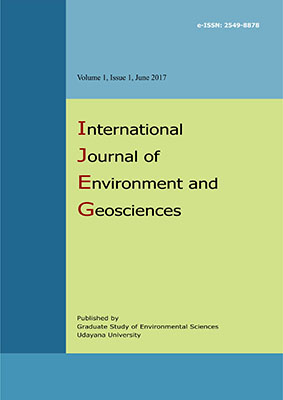Multi-temporal Analysis for Differential Interferometry Synthetic Aperture Radar (D-InSAR) and Its Application to Monitoring Land Surface Displcements
Abstract
Land subsidence rate in Semarang has been observed by D-InSAR technique based on ALOS-PALSAR data on ascending orbits, which is processed by GMTSAR and ArcGIS software. Two kind of methods namely single D-InSAR and Multi-Temporal D-InSAR has been done. By employing SRTM3 and ASTER1 DEM data to remove the topography component, total 67 pairs of inteferogram has generated. Northeast area and shoreline area has largest subsidence about 20-32 cm for 4 years or average rate 5-8 cm/year. Since the northwest area and center area has lower subsidence rate and even no remarkable subsidence occurred, this area seems to be stable comparing the northeast area. Removing the topography component phase to get displacement phase from the phase interferogram by using SRTM3 DEM and ASTER1 DEM data respectively, the both results coincided with 0.995 correlation value. The coherence threshold is an important factor to get better accuracy, but if setting the threshold too high, the process of interference will be failed and not be able to obtain the results in a lot of area. The perpendicular baseline and the temporal baseline (time period) is an important factor to determining the coherence threshold. By using many scenes the Multi-Temporal D-InSAR was applied, and by selecting good pairs of the interferograms, accuracy of the results will be improved. The correlation value for GPS data eventually increased from 0.63 to 0.77.Downloads
Download data is not yet available.
Published
2017-01-28
How to Cite
YASTIKA, Putu Edi et al.
Multi-temporal Analysis for Differential Interferometry Synthetic Aperture Radar (D-InSAR) and Its Application to Monitoring Land Surface Displcements.
International Journal of Environment and Geosciences, [S.l.], v. 1, n. 1, jan. 2017.
ISSN 2549-8878.
Available at: <https://ojs.unud.ac.id/index.php/ijeg/article/view/28827>. Date accessed: 25 nov. 2025.
doi: https://doi.org/10.24843/ijeg.2017.v01.i01.p01.
Issue
Section
Articles
Keywords
ALOS-PALSAR; D-InSAR; GPS; hyperbolic method; land subsidence; multi-temporal method
Authors who publish with this journal agree to the following terms:
- All articles published by International Journal of Environment and Geosciences (IJEG) and Graduate Study of Environmental Sciences, Udayana University are made available under an open access license worldwide immediately. This means everyone has free and unlimited access to the full-text of all articles published in International Journal of Environment and Geosciences (IJEG), and everyone is free to re-use the published material given proper accreditation/citation of the original publication. Open access publication is supported by authors' institutes or research funding agency by payment of a comparatively article processing charge for accepted articles (See Author Fees). International Journal of Environment and Geosciences (IJEG) and Graduate Study of Environmental Sciences, Udayana University publish articles under the Creative Commons Attribution License.
- Authors are able to enter into separate, additional contractual arrangements for the non-exclusive distribution of the journal's published version of the work (e.g., post it to an institutional repository or publish it in a book), with an acknowledgement of its initial publication in this journal.
- Authors are permitted and encouraged to post their work online (e.g., in institutional repositories or on their website) prior to and during the submission process, as it can lead to productive exchanges, as well as earlier and greater citation of published work (See The Effect of Open Access).





